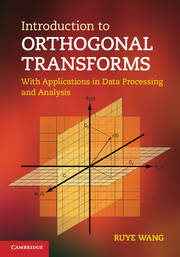Book contents
- Frontmatter
- Contents
- Preface
- Acknowledgments
- Notation
- 1 Signals and systems
- 2 Vector spaces and signal representation
- 3 Continuous-time Fourier transform
- 4 Discrete-time Fourier transform
- 5 Applications of the Fourier transforms
- 6 The Laplace and z-transforms
- 7 Fourier-related orthogonal transforms
- 8 The Walsh-Hadamard, slant, and Haar transforms
- 9 Karhunen-Loève transform and principal component analysis
- 10 Continuous- and discrete-time wavelet transforms
- 11 Multiresolution analysis and discrete wavelet transform
- Appendices
- Bibliography
- Index
10 - Continuous- and discrete-time wavelet transforms
Published online by Cambridge University Press: 05 October 2012
- Frontmatter
- Contents
- Preface
- Acknowledgments
- Notation
- 1 Signals and systems
- 2 Vector spaces and signal representation
- 3 Continuous-time Fourier transform
- 4 Discrete-time Fourier transform
- 5 Applications of the Fourier transforms
- 6 The Laplace and z-transforms
- 7 Fourier-related orthogonal transforms
- 8 The Walsh-Hadamard, slant, and Haar transforms
- 9 Karhunen-Loève transform and principal component analysis
- 10 Continuous- and discrete-time wavelet transforms
- 11 Multiresolution analysis and discrete wavelet transform
- Appendices
- Bibliography
- Index
Summary
Why wavelet?
Short-time Fourier transform and Gabor transform
In Chapter 3, we learned that a signal can be represented as either a time function x(t) as the amplitude of the signal at any given moment t, or, alternatively and equivalently, as a spectrum X(f) = F[x(t)] representing the magnitude and phase of the frequency component at any given frequency f. However, no information in terms of the frequency contents is explicitly available in the time domain, and no information in terms of the temporal characteristics of the signal is explicitly available in the frequency domain. In this sense, neither x(t) in the time domain nor X(f) in the frequency domain provides complete description of the signal. In other words, we can have either temporal or spectral locality regarding the information contained in the signal, but never both at the same time.
To address this dilemma, the short-time Fourier transform (STFT), also called windowed Fourier transform, can be used. The signal x(t) to be analyzed is first truncated by a window function w(t) before it is Fourier transformed to the frequency domain. As all frequency components in the spectrum are known to be contained in the signal segment inside this particular time window, certain temporal locality in the frequency domain is achieved.
Information
- Type
- Chapter
- Information
- Introduction to Orthogonal TransformsWith Applications in Data Processing and Analysis, pp. 461 - 491Publisher: Cambridge University PressPrint publication year: 2012
Accessibility standard: Unknown
Why this information is here
This section outlines the accessibility features of this content - including support for screen readers, full keyboard navigation and high-contrast display options. This may not be relevant for you.Accessibility Information
- 1
- Cited by
